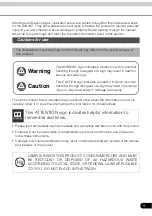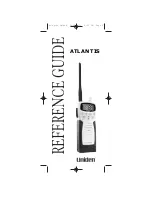
2.5.20 357-05854-03 Rev A © Inovonics, 2020 - www.inovonics.com
2
1.5 EN4200 Security Only Serial Receiver Internal
Components
Figure 2
EN4200 serial receiver components
1.6 EN4200 Security Only Serial Receiver Operation
LEDs
The following LEDs are used to monitor serial receiver operation:
Transmit LED: Lit when the serial receiver is transmitting data to the
application controller.
Receive LED: Lit when the serial receiver is receiving data from the
application controller.
Decode LED: Lit when the serial receiver is decoding an RF transmission
from another Inovonics device.
2 Installation and Startup
2.1 Installation Notes
• These products are designed to be maintained by professional
security technicians.
• Products are tested for indoor use.
• Do not mount wireless smoke detectors, co detectors, initiating device
transmitters or repeaters to removable surfaces, such as ceiling tiles.
• All products should be manually tested weekly.
• The EN4200 must be installed within 30 m (98.5 ft) of control unit.
• Low power transmitters shall be limited to a single initiating device.
2.2 Connect the Serial Cable
Caution:
Long cable runs should not be adjacent to high current power
feeds. Keep cable lengths as short as possible to minimize cable
capacitance. Measure voltage supply at the serial receiver to ensure power
requirement is met for long cable runs.
1.
Connect a serial cable to either the serial data port or the serial data
terminal. Cabling should meet the following specifications:
• Four-conductor 20AWG (or larger) stranded-tinned copper with PVC
insulation rated to 300 volts at 60°C (140°F). (Belden #8205, for
example.)
2.
Route the cabling through either the bottom cabling knockout or the
side cabling knockout.
2.3 Select the Frequency Band
EchoStream products are able to use a range of radio frequencies, and are
shipped from Inovonics set for your geographic area.
• The jumper will be set on the two pins marked NZ to set the frequency
range to 921-928 MHz for New Zealand.
• The jumper will be set on the two pins marked AU to set the frequency
range to 915-928 MHz for Australia.
• The jumper will be removed to set the frequency band to 902-928
MHz for North America.
1.
Ensure the frequency band is set for your geographic are.
2.
If the frequency band is not set for your geographic area, place a
selection jumper on the appropriate frequency band selection pins to
select Australia or New Zealand, or remove it for North America.
Note:
Only devices set for use in North America are configured for UL
installations.
3.
If you have changed the frequency band and the device is powered on,
press the reset button to complete configuration.
2.4 Mount the Serial Receiver
Caution:
Mount the EN4200 EchoStream serial receiver in a location
removed from metal. Metal objects (duct work, wire mesh screens, boxes)
will reduce RF range.
Note:
A best practice is to ensure the EN4200 EchoStream serial receiver
is mounted in an easily accessible location for future maintenance.
4.
Use the provided anchors and screws to mount the serial receiver in a
location accessible for future maintenance.
5.
Close the serial receiver housing.
3 Specifications
Housing dimensions: 6.38" x 3.60" x 1.10" (162.0 mm x 91.4 mm x 27.9
mm).
Weight: 133 g (4.7 oz).
Power requirement: 10-13.5 Vdc, 100 mA.
Radio: Inovonics EchoStream.
Operating frequency: 902-928 MHz (USA) 915-925 MHz (AUS) 921-928
MHz (NZ).
Operating environment: 0-60°C, (32-140°F) up to 90% relative humidity
(non-condensing).
UL listings: UL 365, UL 636, UL 985, UL 1023, ULC/ORD-C1023-74, UL
1610, UL 1076, cUL.
Note:
Inovonics supports recycling and reuse whenever possible. Please
recycle these parts using a certified electronics recycler.
4 Television and Radio Interference
This equipment has been tested and found to comply with the limits for a
Class B digital device, pursuant to Part 15 of the FCC Rules. These limits
are designed to provide reasonable protection against harmful interference
in a residential installation. This equipment generates, uses and can
radiate radio frequency energy and, if not installed and used in accordance
with the instructions, may cause harmful interference to radio
communications. However, there is no guarantee that interference will not
occur in a particular installation. If this equipment does cause harmful
interference to radio or television reception, which can be determined by
turning the equipment off and on, the user is encouraged to try to correct
the interference by one or more of the following measures:
• Reorient or relocate the receiving antenna.
• Increase the separation between the equipment and receiver.
• Connect the equipment into an outlet on a circuit different from that to
which the receiver is connected.
• Consult the dealer or an experienced radio/TV technician for help.
5 FCC Part 15 and Innovation, Science and
Economic Development Canada (ISED)
Compliance
This device complies with part 15 of the FCC Rules, and ISED license-
exempt RSS standard(s). Operation is subject to the following two
conditions: (1) this device may not cause interference, and (2) this device
must accept any interference that may cause undesired operation of the
device.
Le présent appareil est conforme aux CNR Innovation, Sciences et
Développement économique Canada applicables aux appareils radio
exempts de licence. L'exploitation est autorisée aux deux conditions
suivantes: (1) l'appareil ne doit pas produire de brouillage, et (2) l'utilisateur
de l'appareil doit accepter tout brouillage radioélectrique subi, même si le
brouillage est susceptible d'en compromettre le fonctionnement.
A
Housing release tab
B
Frequency band selection pins
C
Serial data port
D
Serial data terminal
E
Bottom cabling knockout
F
Side cabling knockout
G
Transmit LED
H
Receive LED
I
Decode LED
J
Reset button
K
Tamper button spring
F
E
C
D
B
G
H
I
A
J
K





















